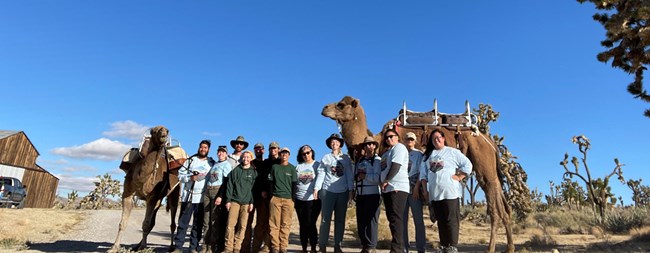Last updated: May 23, 2022
Article
Dome Fire Joshua Tree Restoration Project: Leveraging Volunteer Efforts to Help a Species Imperiled by Climate Change

NPS Photo
In August 2020, the Dome Fire consumed nearly 44,000 acres (70 square miles) in Mojave National Preserve and burned an estimated 1.3 million eastern Joshua trees (Yucca jaegeriana) in one of the largest and densest Joshua tree forests in the world. The fire was just one of the many record-breaking wildfires during the year that turned the skies blood red for much of the Western US. Scientists developed predictive models to forecast how the Joshua trees will respond and shift to changing climatic conditions. One such model predicts that Cima Dome, the location of the fire, could be a refugia for the species (Cole et al., 2011). The perimeter of the Dome Fire overlaps the modelled refugia almost entirely.

NPS Photo
In response to the fire and the existing literature on poor seed dispersal for Joshua trees, park staff initiated a project to restore these plants to the most severely affected areas from the burn. For this restoration project, the park used a variety of outreach methods to attract volunteers and the response was nearly overwhelming. People from all over the country answered the call to come to the desert to help plant and water Joshua trees. During the first year of planting, approximately 140 people contributed over 2,500 volunteer hours to make this project possible. Volunteers ranged in age from 7-76. Geologists, Department of Defense personnel, rocket scientists, off-road enthusiasts, conservationists, utility repair technicians, photographers, construction workers, historians, engineers, lawyers, chemists, students, and retirees all took part in the restoration efforts. A slew of furry friends even assisted, including two camels from a wildlife sanctuary, Herbie and Chico.
References
Cole, Kenneth L., et al. “Past and Ongoing Shifts in Joshua Tree Distribution Support Future Modeled Range Contraction.” Ecological Applications, vol. 21, no. 1, Jan. 2011, pp. 137–49. DOI.org (Crossref), https://doi.org/10.1890/09-1800.1.
